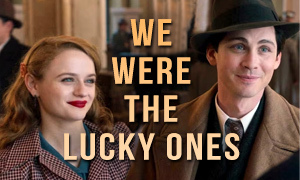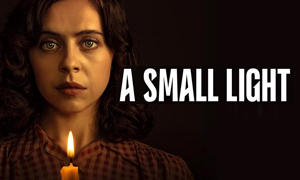The Finest Hours: History vs. Hollywood
| REEL FACE: | REAL FACE: |
Chris Pine
Born: August 26, 1980 Birthplace: Los Angeles, California, USA | Bernie Webber
Born: May 9, 1928 Birthplace: Milton, Massachusetts, USA Death: January 24, 2009, Melbourne, Florida, USA |
Holliday Grainger
Born: March 27, 1988 Birthplace: Didsbury, Manchester, England, UK | Miriam Pentinen
Born: April 30, 1925 Birthplace: Wellfleet, Massachusetts, USA Death: May 14, 2011, Melbourne, Florida, USA |
Ben Foster
Born: October 29, 1980 Birthplace: Boston, Massachusetts, USA | Richard Livesey
Born: February 21, 1930 Death: December 26, 2007, Englewood, Sarasota, Florida, USA |
Kyle Gallner
Born: October 22, 1986 Birthplace: West Chester, Pennsylvania, USA | Andrew Fitzgerald
Born: 1931 Birthplace: Massachusetts, USA |
John Magaro
Born: February 16, 1983 Birthplace: Akron, Ohio, USA | Ervin Maske
Born: April 24, 1929 Birthplace: Marinette, Wisconsin, USA Death: October 7, 2003, Marinette, Wisconsin, USA |
Eric Bana
Born: August 9, 1968 Birthplace: Melbourne, Victoria, Australia | Daniel Cluff
Born: July 4, 1916 Birthplace: Chincoteague, Virginia, USA Death: March 5, 1989, Hillsborough, Florida, USA |
Beau Knapp
Born: April 17, 1989 Birthplace: Los Angeles, California, USA | Mel "Gus" Gouthro
Born: June 6, 1931 |
Was the SS Pendleton really unable to send out a distress call?
Yes. In fact-checking The Finest Hours movie, we learned that the ship, which had been traveling from Baton Rouge, Louisiana to Boston, Massachusetts, broke apart too quickly and the equipment to send out a distress call was lost. "The seas were breaking in every direction," said the real Ray Sybert (Casey Affleck in the movie) shortly after the ordeal. "The tanker cracked right through No. 8 hold, just forward of midship. Right up to that time we had no warning anything was wrong" (The Southeast Missourian). The only thing that still worked was a little portable radio receiver. The Coast Guard spotted the two sections of the Pendleton on radar and began tracking their locations (CG36500.org).
What cargo was the SS Pendleton carrying?
According to The Finest Hours true story, the World War II-era T2 tanker was carrying kerosene and heating oil. The other T2 tanker that broke in half, the SS Fort Mercer, was carrying kerosene. -USCG.mil
Did the ship really break apart due to a previous weld that did not hold?
No. The SS Pendleton had suffered a three-way fracture the year prior, but it was never repaired. Surprisingly, the hastily built WWII-era ship had still passed its last Coast Guard inspection in January 1952, the month before the disaster. Subpar welding methods used in the ship's construction were mainly to blame. It is also likely that the hull of the ship had been constructed with "dirty steel," which means that it contained too much sulfur and was therefore weaker. As a result, T2 tankers like the Pendleton were sometimes referred to as "Kaiser's coffins" and "serial sinkers." -The Finest Hours book
Did some of the Coast Guard members refuse to go out in the storm in such a small boat?
Yes. Fearing that the Coast Guard's 36-foot CG-36500 Motor Lifeboat was no match for such treacherous seas, some crew members chose not to partake in the mission and instead made themselves scarce. Three men volunteered to go with Bernard Webber to help the Pendleton survivors, Petty Officer 2nd Class Andy Fitzgerald, Seaman Richard Livesey and Seaman Ervin Maske. Other crew members from the Chatham Lifeboat Station had already left in another boat in response to the mayday from the Fort Mercer, the other oil tanker that had broken in half. -USCG.mil
How did Bernie meet his wife Miriam?
The real Bernie Webber met Miriam Pentinen over the telephone in 1950. His car had broken down when he was on his way to meet a girl for a date. He found a pay phone and called the girl to explain what had happened. Miriam was the telephone operator who put the call through, but apparently not before having a brief conversation with Bernie. Interested, she called the Chatham Lifeboat Station and began enjoying long phone conversations with Bernie, who eventually asked her out. She declined at first, but eventually agreed on the terms that it had to be a double date. Like in the movie, they had enjoyed a number of phone conversations before ever meeting in person and seeing what each other looked like. -The Finest Hours book
Did Miriam propose to Bernie?
Yes, but in researching The Finest Hours true story, we discovered that unlike the movie, they were already married at the time of the Pendleton rescue. The true story reveals that Bernie Webber's girlfriend Miriam proposed to him after just a few months of dating. It happened while the couple was parked in Bernie's old Plymouth on Nauset Beach (not while dancing). Bernie did initially say, "No," but changed his mind by the end of the date when he dropped Miriam off at her parents' house. "Okay," he said, "I'll marry you." He told her to pick a date and she said July 16 (not April 16). They wed on July 16, 1950 at Bernie's family's home in Milton, Massachusetts, roughly a year and a half prior to the Pendleton rescue (the movie pushes their timeline forward). Bernie's father, a reverend, performed the ceremony. -The Finest Hours book
Was Miriam a telephone operator?
Yes, Miriam had worked as a telephone operator in nearby Wellfleet. However, after they married, they moved into a rather large cottage near the lifeboat station in Chatham so they could see each other more often (Bernie's job in the Coast Guard had meant that they could spend up to 10 days apart at a time). After the move, Miriam began working at the First National Store, which is where she was employed at the time of the Pendleton rescue. -The Finest Hours book
How high were the waves during the rescue?
Fact-checking The Finest Hours movie confirmed that nearby cutters observed sea heights anywhere from 40 to 60 feet. -USCG.mil
Did senior officer Ray Sybert really cut one of the Pendleton's lifeboats loose to prove that it couldn't handle the rough seas?
No. In The Finest Hours movie, Raymond L. Sybert (Casey Affleck), the Pendleton's Chief Engineer and senior officer on board, takes charge after the captain was lost with the bow section. To prove to the crew that lowering the lifeboats was a bad idea, he cuts one loose and they watch it smash against the side of the ship, breaking into pieces. In The Finest Hours book, there is no mention of this demonstration taking place. However, the men did have a big discussion about lowering the lifeboats. Eighteen-year-old seaman Charles Bridges told them the idea was nuts, that the lifeboats could not withstand the monstrous waves, which would likely crush them against the hull. None of the lifeboats were ever launched.
Was the Coast Guard's motor lifeboat really thrown into the air and onto its side in the high waves?
Yes. The Finest Hours true story confirms that after being smashed by a mountainous wave, the CG-36500 rescue boat was thrown high in the air, landing on its side. The self-righting boat quickly corrected itself and was ready to face the next giant wave. -USCG.mil
Did the high seas break the rescue boat's window and compass?
Yes. As Bernie Webber and his crew attempted to navigate the wooden motor lifeboat across the Chatham sandbar and out to the SS Pendleton, the high swells wrecked havoc on the boat. One such swell crashed down over the boat, knocking over coxswain Webber. In addition, the windshield on the coxswain flat was shattered into pieces and the compass was torn from its mounts, leaving them with nothing to guide them to the ship or to allow them to find their way back. They were left with only a searchlight to help them locate the Pendleton in the darkness. Like in The Finest Hours movie, the sound of twisting metal alerted them to the broken Pendleton's location. -Coast Guard Compass
Did Bernie Webber really not wear a life jacket?
Yes. Coxswain Bernie Webber (portrayed by Chris Pine in the movie) decided to not wear a life jacket in order to give himself the best maneuverability to control the motor lifeboat and react to the unpredictable seas. -USCG.mil
Did Ray Sybert really try to run the Pendleton aground?
No. Unlike what unfolds in The Finest Hours movie, Chief Engineer Ray Sybert actually decided to keep the Pendleton's stern as far offshore as possible, fearing that the ship might further break up in the relentless surf. If the ship got close, Sybert ordered that the propeller be turned to keep the ship offshore in more moderate seas. -MWDC.org
Did Miriam really go to the station and plead that Bernie be called back in?
No. Bernie's wife Miriam had been at home in bed with the flu at the time. He had not spoken to her in two days (his job could keep them apart for days at a time). As he was getting ready to depart, he told John Stello, a neighbor and local fisherman, to inform Miriam of what was going on. She never showed up at the Chatham Lifeboat Station like in the movie. Bernie phoned Miriam after the rescue was over. -The Finest Hours book
Did the motor lifeboat's engine really die out?
Yes. Fact-checking The Finest Hours movie revealed that the gigantic waves would roll the boat so far over that the single 90-horsepower gasoline engine would die out because it would lose its prime. Engineer Andy Fitzgerald (Kyle Gallner in the movie) would then have to crawl into the cramped engine compartment to restart it, leaving him with bad burns and bruises. Though they likely wouldn't have survived without getting the engine restarted, the movie dramatizes things a bit by giving them only seconds to get it restarted before they will be crushed by a gigantic wave. -The Finest Hours book
How many survivors did Bernie Webber and his team rescue?
With a crew of only four (including himself), Bernard "Bernie" Webber was dispatched from Chatham, Massachusetts to rescue the survivors of the sinking 503-foot SS Pendleton oil tanker, which had broken in half in the early morning hours of February 18, 1952 during a powerful winter storm. Using Coast Guard Motor Lifeboat CG-36500, Bernie and his team rescued 32 crew members from the SS Pendleton. Each one descended a rope ladder with wooden steps (Jacob's ladder) that had been lowered over the tilted hull of the ship. Bernie and his team approached the stern of the floundering tanker more than 30 times, rescuing each sailor one by one. The Coast Guard's 36-foot lifeboat had been designed to carry only 12 people. -Coast Guard Compass
How many men lost their lives from the SS Pendleton?
When a nor'easter broke the SS Pendleton in half approximately one mile off the coast of Cape Cod, Massachusetts, eight men who were in the bow of the ship at the time, including the captain, lost their lives. The ship supposedly broke apart much like it does in the The Finest Hours movie, with a slew of sudden roaring cracking noises. The real Ray Sybert, who is portrayed by Casey Affleck in the film, said that the ship breaking apart sounded "like the roar of thunder." -The Southeast Missourian
There was more hope for the remaining 33 men in the stern of the ship. However, they feared a similar fate as the stern drifted in 60-foot seas toward the treacherous Chatham sandbar. When Bernie Webber and three other Coast Guardsmen arrived in their small motor lifeboat to help, they were able to get all but one of the Pendleton survivors into their craft, saving 32 of the 33 men who had been in the stern. In all, a total of nine Pendleton sailors lost their lives. Of the 84 crew members who were on the two ships that broke in half, the SS Pendleton and SS Fort Mercer, 70 men were rescued and 14 lost their lives. -TheWashingtonPost.com
Did a crew member jump too soon from the rope ladder and die when he was smashed between the Coast Guard boat and the Pendleton?
Yes. The Finest Hours true story reveals that a 300-pound man named George "Tiny" Myers was the last survivor to be rescued from the SS Pendleton, aside from its de facto captain, Raymond L. Sybert. Myers lost his life when he jumped from the rope ladder that had been lowered by the Pendleton crew in order to descend into the Coast Guard lifeboat. Myers missed the rescue boat and fell into the frigid, virulent sea. He was then smashed between the Coast Guard vessel and the SS Pendleton. His death haunted Bernie Webber and his fellow Coast Guardsmen for years. -USCG.mil
Why weren't more rescue vessels able to come to the aid of the sinking SS Pendleton?
In addition to motor lifeboat crews from Cape Cod and Nantucket Island, cutters Yakutat, Unimak, Eastwind, McCulloch and Acushnet and aircraft from nearby stations responded to the two tankers in distress. However, by the time they received news of the second tanker, the SS Pendleton, most of the Coast Guard's rescue resources were being utilized to help the sinking SS Fort Mercer, another World War II-era oil tanker that had broken apart in the storm but was able to send out a distress call before breaking up. The motor lifeboat captained by Petty Officer 1st Class Bernard Webber ended up rescuing all 32 survivors from the SS Pendleton on its own. -Coast Guard Compass
Were local citizens really listening to the rescue unfold via radio?
Yes, and the locals showed up at the pier to meet the Coast Guard's Motor Lifeboat CG-36500 in order to help remove the 32 survivors and drive them to the Coast Guard station where it was warm (Coast Guard Compass). Bernie's wife Miriam, however, was still at home with the flu (The Finest Hours book).
Did car headlights really help to guide the CG-36500 motor lifeboat to the pier?
No. Both Michael J. Tougias and Casey Sherman, authors of The Finest Hours book, have pointed out that this part of the movie is pure fiction. Instead, Bernie Webber spotted the blinking red light of the buoy inside the Chatham Bar, which marked the way into Old Harbor and to the Chatham Fish Pier. Also, the bright beam from the Chatham Lighthouse could be seen for 20+ miles, depending on the conditions, and would have been well within the range of the lifeboat and the pier.
What happened to the crew of the other ship that broke in half, the SS Fort Mercer?
As we fact-checked The Finest Hours, we learned that the SS Fort Mercer, an oil tanker that had been traveling from Louisiana to Maine, broke apart at around 8 a.m. on the morning of February 18, 1952. It split in two a few hours after the SS Pendleton, which broke apart at about 5:50 a.m. less than 40 miles away. Unlike the Pendleton, which waited in silence for eight hours to be discovered, the Fort Mercer was able to send out an SOS before she broke in half. 38 men from the Fort Mercer were eventually rescued and five lost their lives.
Was the rescue of the SS Fort Mercer survivors just as incredible?
The rescue attempt for the SS Fort Mercer was almost just as incredible as the Pendleton rescue effort. William R. Kiely, Jr. earned a Gold Lifesaving Medal for his efforts, guiding a small surfboat to the Fort Mercer in heavy seas. At one point, his small boat slammed into the Fort Mercer's Hull. Kiely and his crew recovered two survivors before they returned to the larger Coast Guard vessel, the CGC Yakutat, as they took on water. Kiely was joined by other ships, which assisted in the rescue. The last survivor jumped to safety from the Mercer's bow section just seventeen minutes before it reared up and sank. -TheWashingtonPost.com
Did the rescue of the Pendleton crew members really go down in history as one of the Coast Guard's most daring rescue attempts?
Yes, and for their heroic efforts, the four-man crew of the motor lifeboat, including Bernard Webber, Richard Livesey, Andrew Fitzgerald and Ervin Maske, were each awarded the Coast Guard's Gold Lifesaving Medal. Webber credits the Lord as having a hand on the tiller during the rescue. -CG36500.org
The Finest Hours Interviews & Movie Trailer
Dive deeper into The Finest Hours true story by watching a featurette that includes an interview with former Coast Guardsman Andy Fitzgerald, portrayed by Kyle Gallner in the movie.
Link-to-Learn More:







